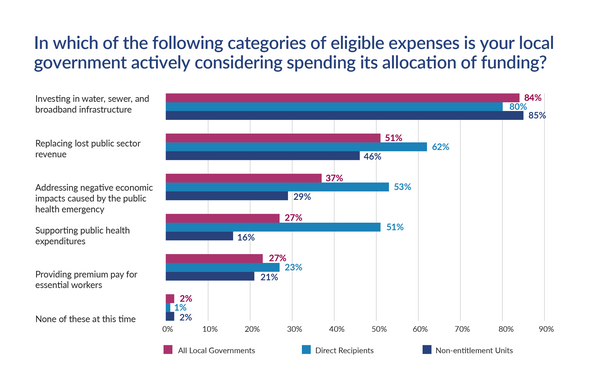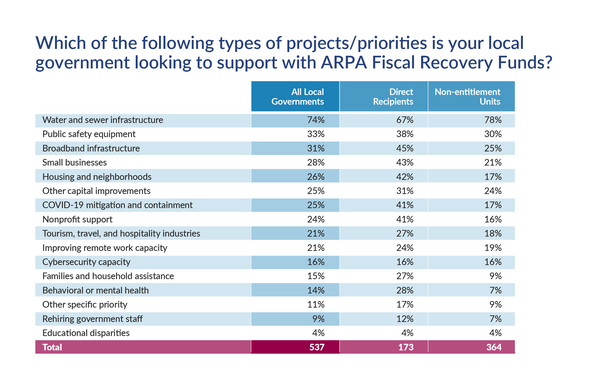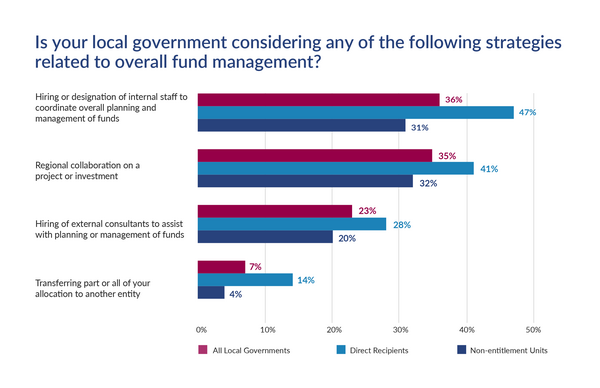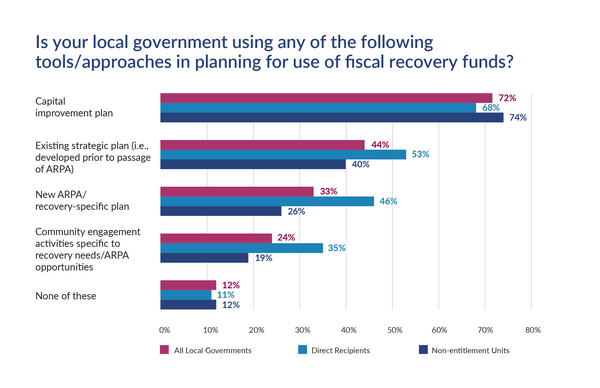
ICMA surveyed local government chief administrative officers about their priorities for using the American Rescue Plan Act (ARPA)’s Local Fiscal Recovery Funds, based on available guidance as of September 2021. More than 530 town, city, and county managers responded. Two-thirds of the responses came from communities of 25,000 or fewer residents, which fall under the FRF definition of “Non-entitlement Units (NEUs).” This article highlights preliminary findings based on data collected through September 20, 2021.
Major Investment Priorities
Infrastructure was the top investment priority for communities of all sizes, followed by replacing lost public sector revenue.

Within the infrastructure category, most anticipated projects and priorities concern water and sewer infrastructure—prioritized by 74 percent of respondents. Broadband infrastructure is being considered by 45 percent of direct recipients and 25 percent of smaller communities/NEUs.
Overall, half of the survey respondents anticipate replacing lost public sector revenue according to Treasury’s guidelines. Direct recipients are more frequently considering this option, as well as addressing negative economic impacts of the pandemic and supporting public health expenditures.

Within these more specific priority areas, we observe additional differences between larger and smaller communities, notably in areas such as COVID-19 mitigation and containment; housing and neighborhoods; nonprofit support; small businesses; and behavioral or mental health—all areas where larger communities are more likely to prioritize spending. Smaller communities overwhelmingly prioritize water and sewer infrastructure and indicated fewer additional priority areas.
Emerging Examples
While many local governments are continuing to gather information and explore potential investments, some have already taken steps to launch or advance initiatives made possible with fiscal recovery funds. Examples include:
- Household Relief. Kenmore, Washington, is an NEU (population 23,000) anticipating $6 million in Fiscal Recovery Funds, which they intend to devote to addressing the negative economic impacts of the pandemic. As a significant part of this effort, the city will dedicate $1 million toward direct cast assistance to low-income households at 30 percent or below area median income. The city issued an RFP in July to identify a community partner to distribute funds and awarded a contract in September to their regional education foundation. Plans assume approximately 2,600 verified residents will receive $375 payments, no strings attached.
- Varying Approaches to Regional Broadband. In the Lake Cities region of Texas, four smaller municipalities (Corinth, population 22,000; Hickory Creek, population 4,600; Lake Dallas, population 8,000; and Shady Shores, population 2,800) have been collaboratively assessing and planning around broadband issues even prior to the pandemic. With the availability of Fiscal Recovery Funds, the cities hope to establish a middle mile/government services fiber ring, and have issued an RFP to leverage this infrastructure in a public-private partnership to extend connections to their residents and businesses. Port St. Lucie, Florida, is a direct recipient with a population of 202,000. It expects to use the bulk of its allocations to provide water, sewer, and drainage infrastructure for a commerce park and two regional projects that were previously unfunded. Additionally, the city will use funds to establish critical links to its fiber system and connect the city to the county’s fiber system. While the investment itself is not a joint project, the end result will be a regionally integrated fiber network.
- Investing in Community Resiliency. In developing a draft budget for its $40 million direct allocation, Davenport, Iowa (population 102,000), utilized extensive public feedback and a city council prioritization process. To put proposed ideas in context, staff prepared summaries noting whether projects would incur operational costs beyond the ARPA funding timeframe; whether partnerships would be required to complete; and how concepts aligned with the city’s resiliency priorities for dynamic destinations, strong foundations, and a vibrant economic future. In July, the city council approved an ARPA spending plan that included investments in flood mitigation, housing for vulnerable residents, youth-oriented programming, park and public space improvements, and other infrastructure projects.
Management and Coordination
Nearly half (47 percent, not shown in chart below) of overall respondents anticipate hiring or designating coordinators for overall planning and management of these funds. Local governments are more frequently looking at hiring or designating this role internally, but 23 percent overall (more frequently direct recipients) are considering engaging external consultants.
Overall, one-third of respondents are considering regional collaboration on a project or investment. Fourteen percent of direct recipients anticipate transferring at least part of their allocation to another entity.

What’s Driving Prioritization
Capital improvement plans are highly influential in setting priorities for Fiscal Recovery Fund spending, used by three out of four communities as a part of their planning. Approximately 40 percent of NEUs and over half of direct recipients are utilizing strategic plans developed prior to the passage of the Rescue Plan legislation. Half of responding direct recipients and a quarter of responding NEUs have developed new recovery/ARPA-specific plans within the last several months. A quarter of local governments have conducted community engagement activities specific to pandemic recovery and ARPA opportunities.

Outstanding Questions
Respondents are anxious for final guidance from Treasury, with some specifically noting risk-averse governing bodies reluctant to make any commitments until final guidelines are issued. Others remain hopeful that Treasury will clarify ambiguities or amend guidelines on revenue loss provisions and eligible infrastructure projects beyond water, sewer, and broadband.
Next Steps
ICMA will continue to collect information about local government priorities, processes, project examples, and questions regarding ARPA’s Fiscal Recovery Funds, including at our upcoming conference. Findings and examples will be available on our dedicated ARPA resource page, and local government leaders can also share related questions with ICMA via this form.
New, Reduced Membership Dues
A new, reduced dues rate is available for CAOs/ACAOs, along with additional discounts for those in smaller communities, has been implemented. Learn more and be sure to join or renew today!
